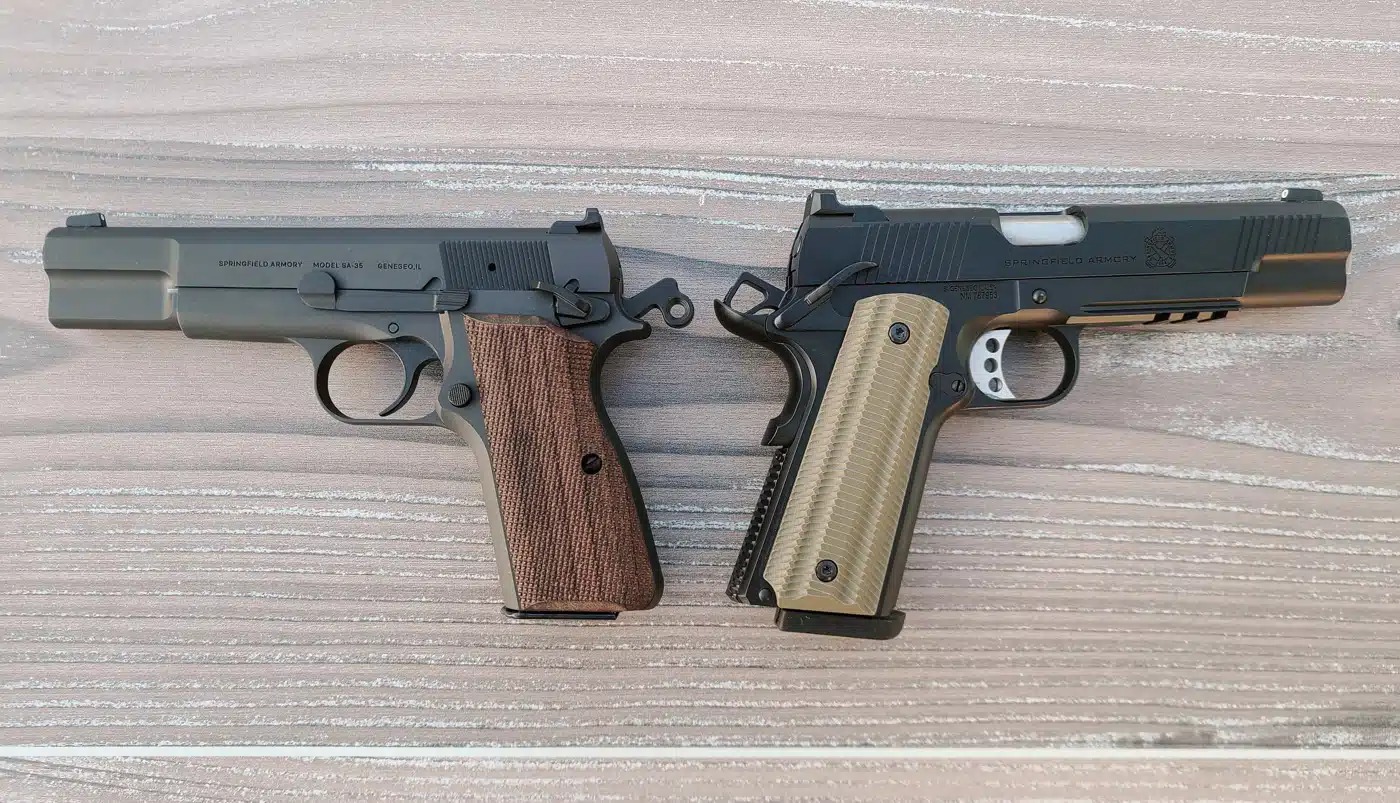
Among the full-size, steel-frame 9mm handguns from Springfield Armory, the SA-35 captures my attention. It’s a remarkable John Browning creation that presents an evolution of the 1911 pistol design, incorporating a double-stack 9mm magazine. Browning’s ingenuity shines through, having crafted a sidearm that continues to be cherished by shooters even in modern times.
The classic “P-35” was developed with the intention of providing, among other benefits, a higher ammunition capacity within a pistol. Browning achieved this by introducing a double-stack magazine capable of holding 13 rounds, making it an exceedingly attractive choice.
Introducing the SA-35
Springfield Coltbacbactgun has crafted their interpretation of the P-35 design, infusing modern elements while preserving the integrity of the original and iconic blueprint. Allow me to introduce the Springfield Armory SA-35.
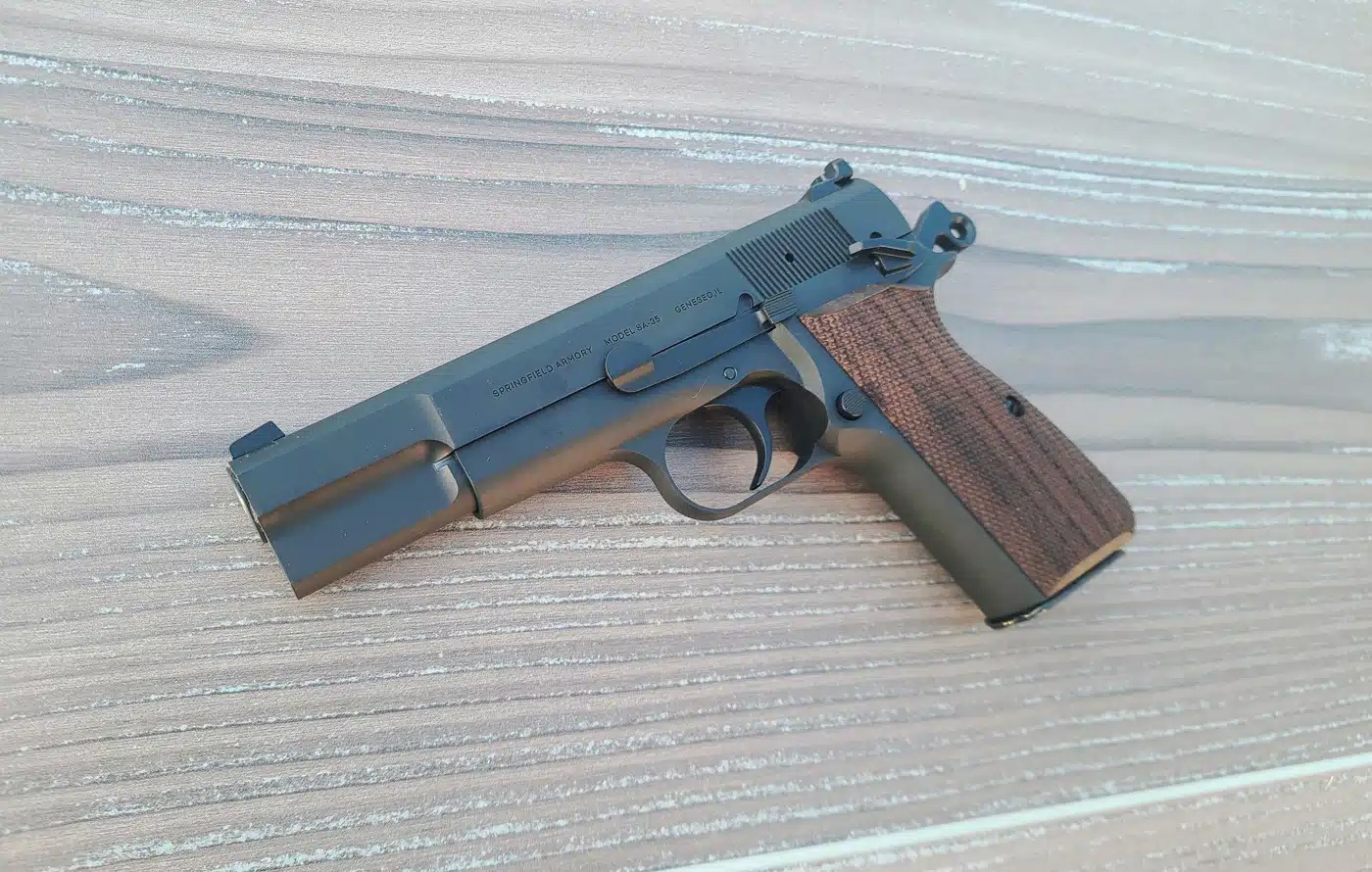
In early 2022, Springfield unveiled the SA-35 to the firearms community, generating tremendous enthusiasm. As we delve into this review, you’ll observe how Springfield has revisited the original design and incorporated subtle yet meaningful improvements to better cater to today’s shooters.
What Exactly Is It?
The SA-35 is a full-sized 9mm handgun featuring a 4.7-inch barrel and crafted from forged steel for both the slide, frame, and barrel. It boasts a matte blued finish on the slide and frame, complemented by a serrated black rear sight and a front dot sight mounted on the slide.
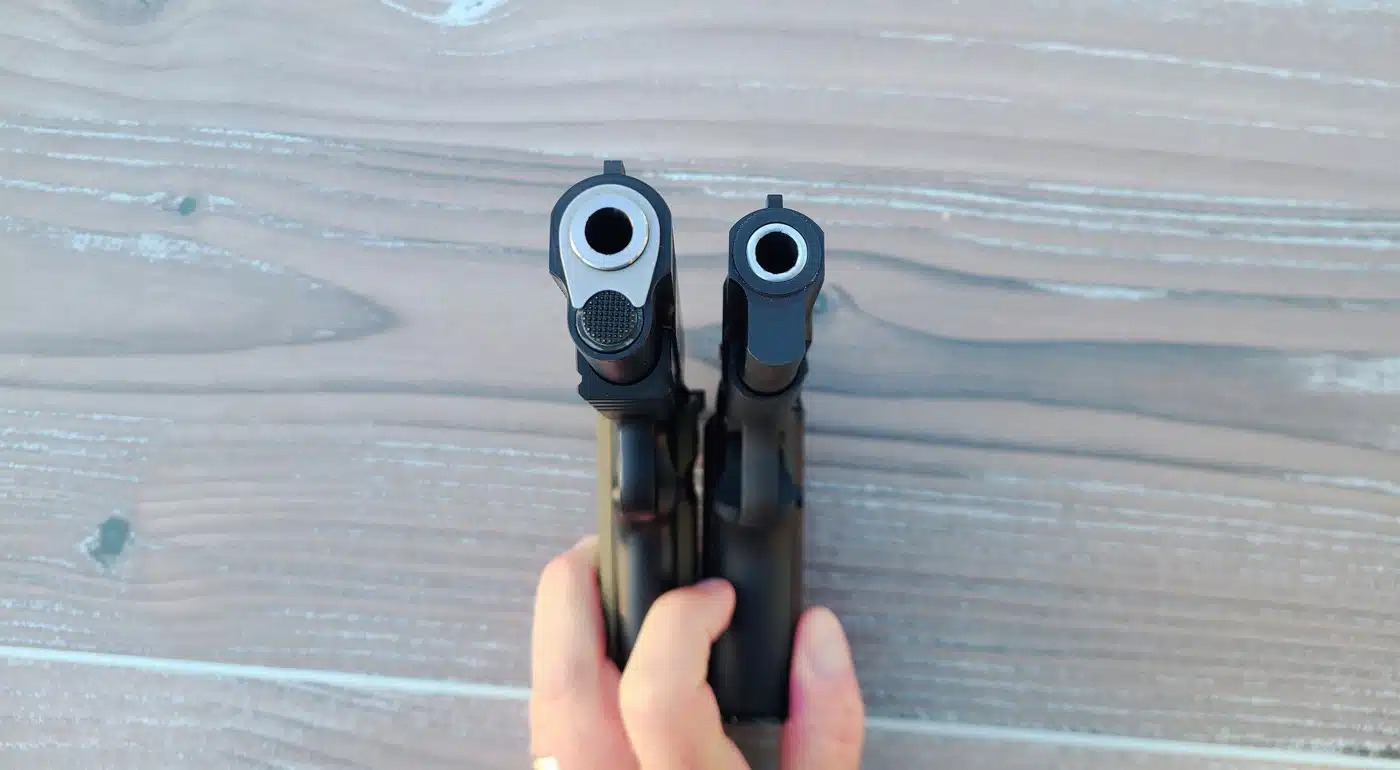
Springfield has elevated the magazine capacity from the original design to accommodate 15 rounds. The wood checkered grips feature fine texturing and stylish vertical black lines, adding to their visual appeal.
A recurring issue with the original design was the problem of “hammer bite.” Several shooters voiced concerns that the spurred hammer would extend beyond the beavertail and make contact with the web of the hand. Springfield has addressed this concern by replacing the spurred hammer with a ring hammer, effectively eliminating the possibility of the troublesome hammer bite.
The most significant enhancement, in my opinion, is the lighter single-action trigger. In comparison to my original pistol, which has a rather hefty single-action trigger measuring 9 lbs on my scale, the SA-35 features a much more manageable 5.5-lb trigger. This adjustment significantly enhances the shooting experience with the pistol.
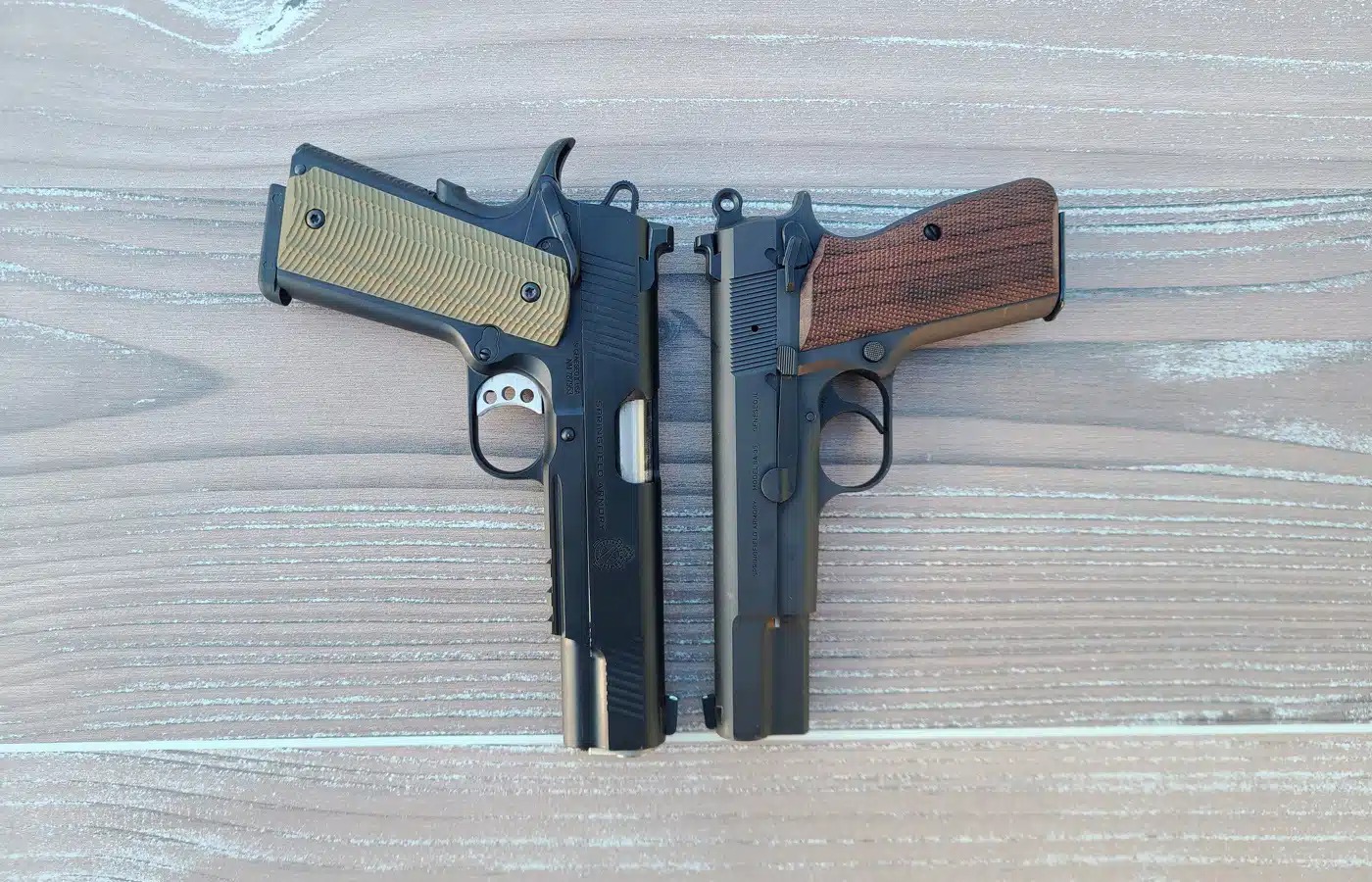
Further enhancements encompass the elimination of the magazine disconnect and the incorporation of a broader thumb safety, facilitating more convenient engagement and disengagement of the safety.
Why Conduct This Review?
I found it intriguing to conduct a comparison between two of Browning’s iconic handguns. In order to do this, a 1911 had to be included in the equation. I chose to evaluate the SA-35 alongside the Springfield 1911 Operator chambered in 9mm. I have an affinity for both of these pistols. Despite sharing a few common features, they also exhibit notable differences in various aspects. Now, let’s delve into the details of the 1911 Operator in 9mm.
Explain me About the 1911 Operator?
The Springfield Coltbactgun offers a .45 ACP 1911 Operator model that seamlessly combines contemporary enhancements with the classic attributes of the original 1911 pistol design.
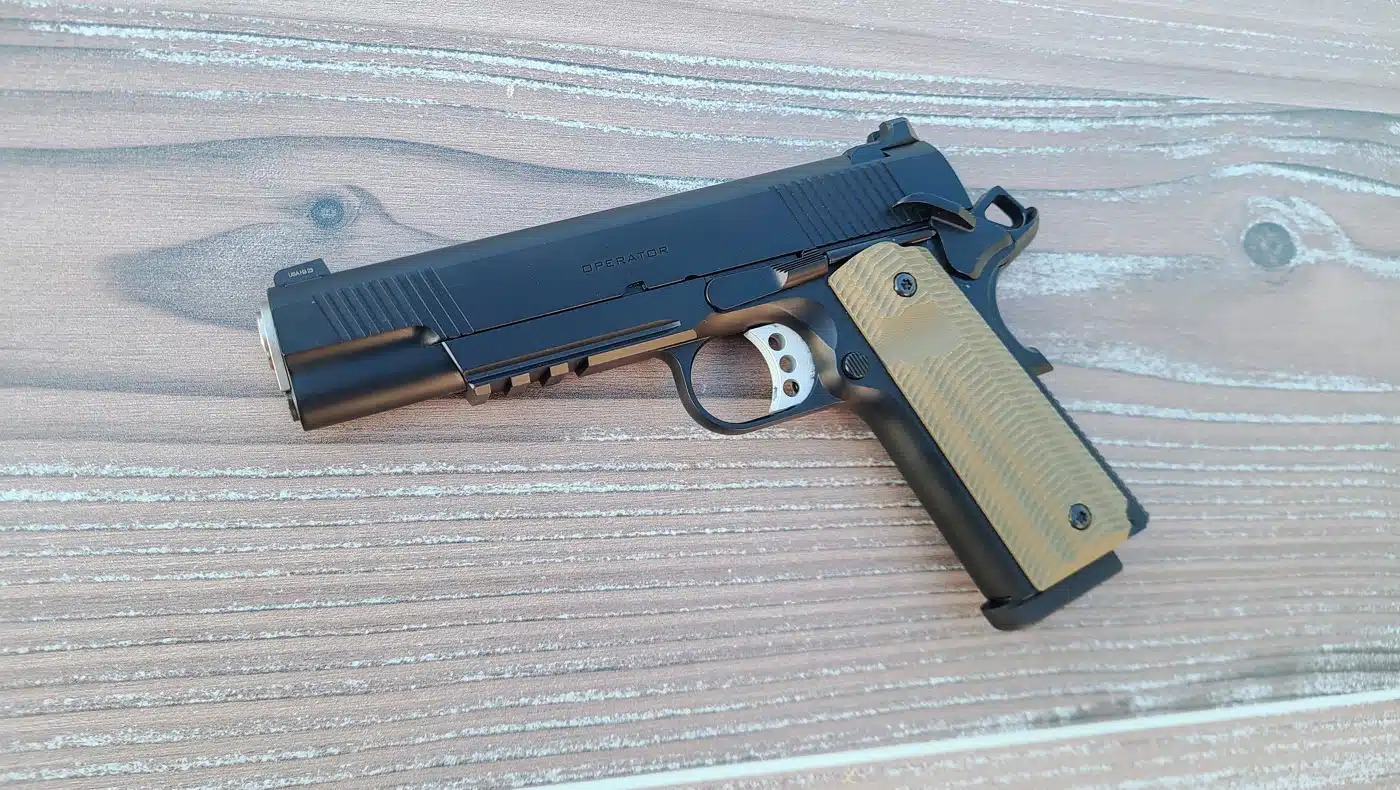
The 9mm version of the 1911 Operator maintains an identical look and feel to its counterpart, differing primarily in chambering and magazine capacity. While the .45 ACP model employs an eight-round magazine, the 9mm variant features a nine-round magazine. It’s complemented by striking desert tan VZ G-10 grips that beautifully complement the black Cerakote slide and frame.
Equipped with an ambidextrous thumb safety, forward slide serrations, and three-dot sights featuring a tritium front night sight, this model also boasts a Picatinny rail for attaching a light. Furthermore, its trigger is nothing short of exceptional.
The 1911 Operator features a single-action trigger with a crisp 4 lbs. break and an exceptionally short reset. This consistency aligns with Springfield Armory’s renowned 1911 line, making it a top choice for those in search of a dependable 1911 pistol. The firearm’s exceptional build quality, high-quality components, and impressive shooting accuracy make it a standout choice.
You mentioned that this was a comparison...
The 1911 Operator features a single-action trigger with a crisp 4 lbs. break and an exceptionally short reset. This consistency aligns with Springfield Armory’s renowned 1911 line, making it a top choice for those in search of a dependable 1911 pistol. The firearm’s exceptional build quality, high-quality components, and impressive shooting accuracy make it a standout choice.
Capacity of the Magazine
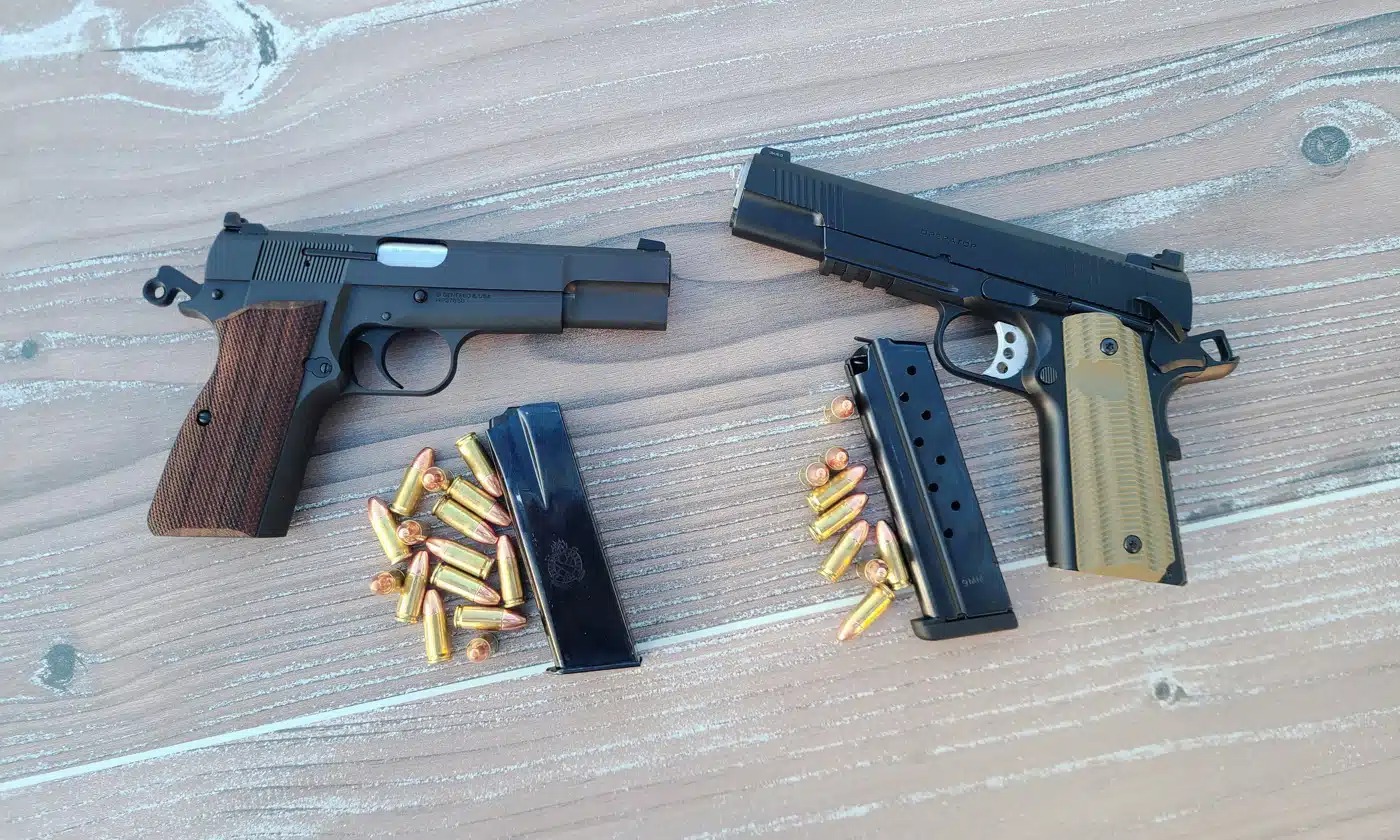
The SA-35 features a double-stack 9mm magazine with a capacity of 15 rounds, whereas the 1911 Operator is equipped with a single-stack 9mm magazine holding nine rounds. The choice in this category is rather clear: SA-35 takes the lead.
Handle Panels
The SA-35 comes with checkered wood handle panels, while the 1911 Operator is equipped with G-10 grips. While wood grips are commonly found on 1911 pistols and offer a traditional appeal, in this comparison, the enhanced texturing of the VZ G-10 grips on the 1911 Operator was the decisive factor. Therefore, the 1911 Operator prevails in this category.
Exterior Coating
I have a strong preference for Cerakote finishes, as they are highly resistant to scratching and wear, which is crucial for pistols that frequently enter and exit holsters. In my opinion, Cerakote stands out as the most durable and robust finish available. While the SA-35’s matte black finish complements its traditional aesthetics, the edge in terms of durability goes to the 1911 Operator, thanks to its stunning Cerakote finish.
Beavertail and Handguard Safety
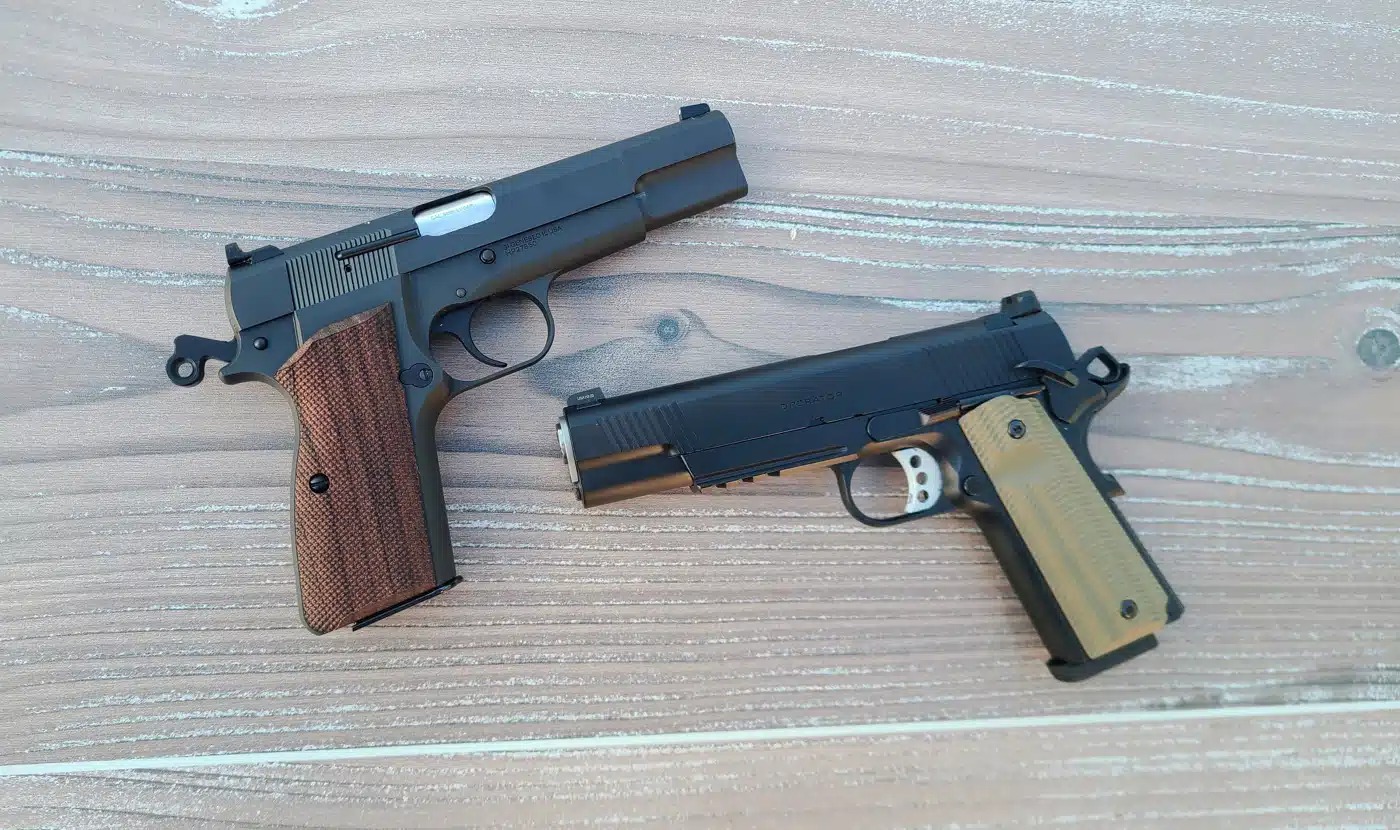
The SA-35 features a relatively shorter and less conspicuous beavertail without a thumb safety. On the other hand, the 1911 Operator comes with a longer beavertail and a classic 1911 grip safety. Springfield Armory has maintained common and traditional features in the design of both these pistols, making it challenging to make a definitive choice. As a result, I’m declaring this category a draw.
Manual Safety and Hammer
In these two aspects, Springfield has enhanced the original P-35 design. They widened the left-side-only manual safety, providing more surface area for the thumb to rest on when engaging or disengaging it. Additionally, they introduced a ring hammer to prevent any instances of hammer bite.
The 1911 Operator is equipped with an ambidextrous thumb safety and a skeletonized hammer. While one might anticipate my preference for the 1911 Operator due to its left-handed user-friendly thumb safety, my choice leans towards the SA-35. This is because I consider the wider thumb safety and the introduction of the ring hammer in the SA-35 to be substantial improvements over the original P-35 design.
Firearm Sights
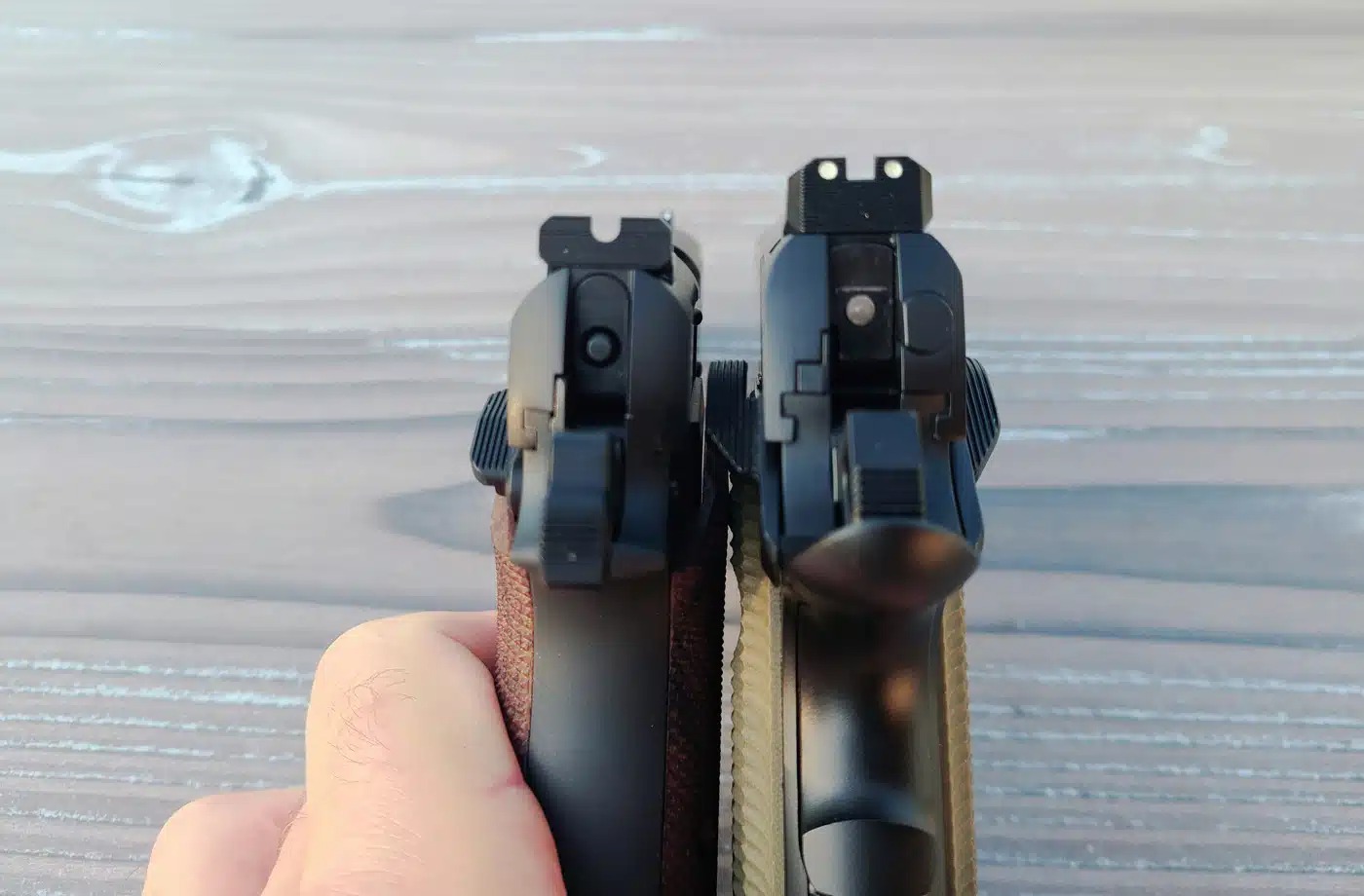
When it comes to sights, the comparison between the serrated black rear sight on the SA-35 and the two-dot rear sight on the 1911 Operator results in a tie. However, it’s worth noting that the 1911 Operator boasts a tritium day/night front sight. In my opinion, the 1911 Operator’s sight system is the clear choice for anyone with a pulse. Nevertheless, it’s essential to consider the price difference as well.
Firearm Trigger
I’m an unwavering enthusiast of the 1911 platform. When it comes to firearms, few things bring me more joy than shooting a 1911. The key factor in this affection is the crisp and light single-action trigger pull, which significantly contributes to accuracy and rapid follow-up shots. Springfield’s remarkable effort in transforming the once heavy P-35 trigger into a lighter version with the SA-35 is like night and day. However, in this particular aspect, the 1911 Operator’s trigger ultimately takes the lead.
Dismantling Process
Both handguns feature a combined takedown/slide stop lever, and both require the removal of this lever for disassembly. Notably, the SA-35 lacks a removable barrel bushing, streamlining the disassembly process with fewer steps. As a result, I opt for the SA-35 due to its simpler disassembly procedure.
Cost
As previously mentioned, the manufacturer’s suggested retail price (MSRP) for the SA-35 stands at $799, whereas the MSRP for the 1911 Operator is $1,184, creating a $385 difference between the two. While I don’t offer financial advice, it’s evident that with $385, a shooter could acquire around 1,500 rounds of 9mm ammunition. Setting aside all other considerations, the SA-35 prevails as the more budget-friendly option. On the flip side, the Operator offers a multitude of excellent features at its price point.
Range Performance
Allow me to express that I’ve thoroughly enjoyed both of these pistols. Each range session with either of these firearms is a rewarding experience for the shooter. Both handguns have consistently demonstrated reliability and exceptional accuracy straight out of the box. I admire the improvements Springfield Armory has made to the SA-35, enhancing an already proven platform. Similarly, the 1911 Operator impresses with its incorporation of modern features while staying true to its classic design.
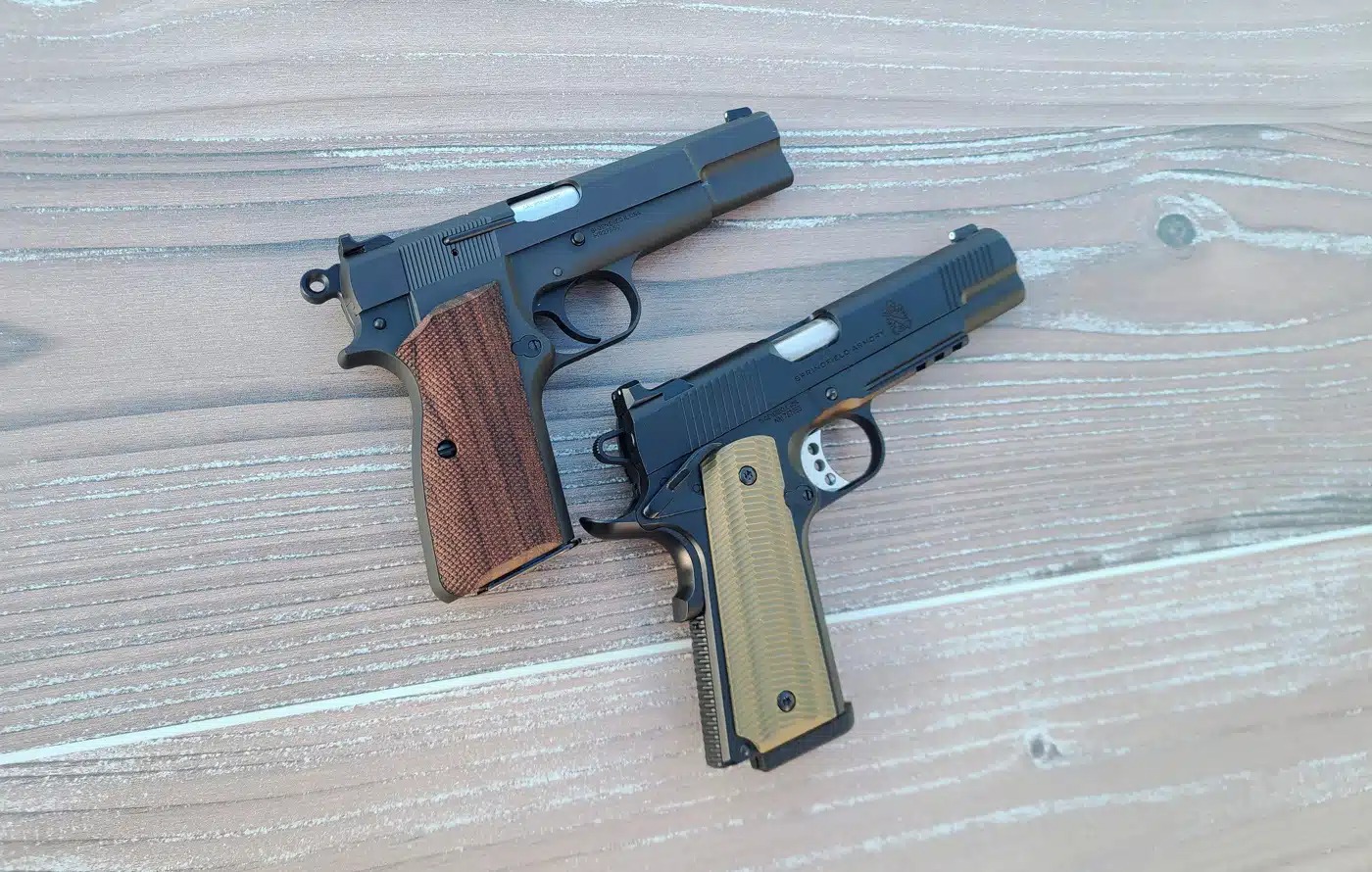
Performance was strong with both pistols. Nevertheless, my preference leans toward the 1911 Operator. As I previously noted, I have a deep affinity for 1911 handguns, and it’s exceptionally rare for me to opt for any other pistol over a 1911 in terms of accuracy.
Final Thoughts
Performance was strong with both pistols. Nevertheless, my preference leans toward the 1911 Operator. As I previously noted, I have a deep affinity for 1911 handguns, and it’s exceptionally rare for me to opt for any other pistol over a 1911 in terms of accuracy.
